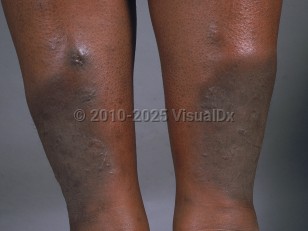Pretibial myxedema
See also in: Cellulitis DDxAlerts and Notices
Important News & Links
Synopsis

Pretibial myxedema, also known as localized myxedema or thyroid dermopathy, is an uncommon finding in autoimmune thyroid disease and most commonly affects those with Graves disease. While only present in 1%-5% of patients with Graves disease, it is the second most common extrathyroidal manifestation. Cases have also been reported in association with Hashimoto thyroiditis and in euthyroid patients.
Pretibial myxedema classically affects the pretibial region but can affect other areas, including the ankles and dorsal feet as well as the hands, arms, shoulders, ears, and face, skin grafts, surgical scars, sport injuries, and animal bites.
Pretibial myxedema may exist in various clinical forms. The nonpitting type is most common, followed by nodular and plaquelike forms. Polypoid and elephantiasic types account for only < 1% of cases. More than one type can coexist. The lesions are usually asymptomatic. Rarely, they may cause pain or ulcerate.
Pathophysiology is not fully understood but likely involves the expression of thyrotropin (TSH) receptors by skin fibroblasts, which are the target of circulating autoantibodies. Activation of fibroblasts leads to excessive production and accumulation of glycosaminoglycans (GAGs), including hyaluronic acid, in the dermis and subcutis, and thus greater osmotic pressure. The pretibial region is most commonly involved because it is thought to be related to local cues, evidenced by development of pretibial myxedema in grafted skin. Development in areas of repetitive trauma and dependent edema suggests a mechanical contribution to its pathogenesis.
Pretibial myxedema may occur in any age group and either sex but is more common in older adults and women. There are rare case reports of its occurrence in children. The diagnosis of Graves disease often precedes the development of dermopathy by 1-2 years. It is almost always associated with ophthalmopathy. More severe cases may be associated with acral changes termed thyroid acropachy (most often clubbing).
Pretibial myxedema classically affects the pretibial region but can affect other areas, including the ankles and dorsal feet as well as the hands, arms, shoulders, ears, and face, skin grafts, surgical scars, sport injuries, and animal bites.
Pretibial myxedema may exist in various clinical forms. The nonpitting type is most common, followed by nodular and plaquelike forms. Polypoid and elephantiasic types account for only < 1% of cases. More than one type can coexist. The lesions are usually asymptomatic. Rarely, they may cause pain or ulcerate.
Pathophysiology is not fully understood but likely involves the expression of thyrotropin (TSH) receptors by skin fibroblasts, which are the target of circulating autoantibodies. Activation of fibroblasts leads to excessive production and accumulation of glycosaminoglycans (GAGs), including hyaluronic acid, in the dermis and subcutis, and thus greater osmotic pressure. The pretibial region is most commonly involved because it is thought to be related to local cues, evidenced by development of pretibial myxedema in grafted skin. Development in areas of repetitive trauma and dependent edema suggests a mechanical contribution to its pathogenesis.
Pretibial myxedema may occur in any age group and either sex but is more common in older adults and women. There are rare case reports of its occurrence in children. The diagnosis of Graves disease often precedes the development of dermopathy by 1-2 years. It is almost always associated with ophthalmopathy. More severe cases may be associated with acral changes termed thyroid acropachy (most often clubbing).
Codes
ICD10CM:
E05.90 – Thyrotoxicosis, unspecified without thyrotoxic crisis or storm
SNOMEDCT:
78146007 – Pretibial myxedema
E05.90 – Thyrotoxicosis, unspecified without thyrotoxic crisis or storm
SNOMEDCT:
78146007 – Pretibial myxedema
Look For
Subscription Required
Diagnostic Pearls
Subscription Required
Differential Diagnosis & Pitfalls

To perform a comparison, select diagnoses from the classic differential
Subscription Required
Best Tests
Subscription Required
Management Pearls
Subscription Required
Therapy
Subscription Required
References
Subscription Required
Last Reviewed:08/11/2019
Last Updated:08/13/2019
Last Updated:08/13/2019
Pretibial myxedema
See also in: Cellulitis DDx
